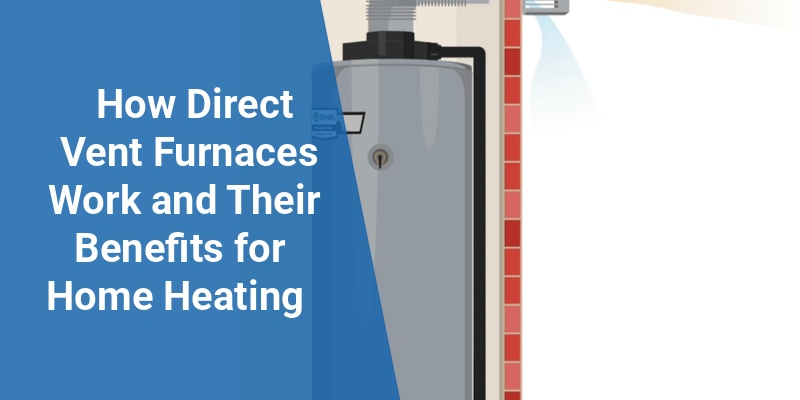A direct vent furnace is a modern heating system designed to efficiently and safely heat homes by using outdoor air for combustion and venting exhaust gases directly outside. Unlike traditional furnaces that rely on indoor air, direct vent systems improve indoor air quality and energy efficiency. This article explores how direct vent furnaces operate, their advantages, installation considerations, and why they are increasingly popular in American households.
| Feature | Description |
|---|---|
| Combustion Air Source | Uses sealed pipe to draw air directly from outside |
| Exhaust Venting | Exhaust gases expelled outside through a separate sealed pipe |
| Energy Efficiency | Prevents heat loss by avoiding indoor air usage for combustion |
| Installation Types | Wall-mounted or roof venting options |
| Safety | Sealed combustion reduces carbon monoxide risks |
What Is A Direct Vent Furnace?
A direct vent furnace is a heating system that uses two sealed pipes: one to bring in fresh air from outside for combustion, and another to vent exhaust gases outdoors. Unlike conventional furnaces, which pull combustion air from inside the home, direct vent furnaces operate with sealed combustion, ensuring that indoor air remains separate from the combustion process. This design not only enhances safety by reducing the risk of indoor air contamination but also improves heating efficiency.
How Direct Vent Furnaces Work
Direct vent furnaces utilize a heat exchanger where the fuel (usually natural gas or propane) burns using air drawn directly from outdoors. The system features two pipes: an intake pipe for combustion air and an exhaust pipe to release byproducts like carbon monoxide. These pipes are usually installed through an exterior wall or roof, allowing the furnace to maintain a sealed environment.
The furnace’s fan circulates warm air through the home’s duct system, while exhaust gases are safely expelled outside. This process ensures efficient fuel combustion and prevents backdrafting, which can introduce harmful gases indoors.
Key Components
- Sealed Combustion Chamber: Keeps combustion isolated from indoor air.
- Intake Pipe: Draws fresh air directly from outside.
- Exhaust Pipe: Vents combustion gases outside safely.
- Heat Exchanger: Transfers heat from combustion gases to circulated air.
- Blower Fan: Distributes heated air throughout the home.
Benefits of Using a Direct Vent Furnace
Direct vent furnaces offer several advantages for homeowners seeking reliable and safe heating solutions.
Energy Efficiency
Using outdoor air for combustion prevents the furnace from consuming heated indoor air, reducing heat loss and energy waste. This contributes to lower utility bills and improved heating efficiency compared to traditional furnaces.
Improved Indoor Air Quality
Since combustion air is sourced externally and exhaust gases are vented outdoors, there is minimal risk of carbon monoxide or other pollutants entering the home. This enhances indoor air safety and quality, especially in tightly sealed, modern homes.
Call 888-906-9139 for Free Local HVAC Quotes – No Obligation, Just Savings!
Safe Operation
The sealed combustion design decreases risks associated with backdrafting and carbon monoxide buildup, making direct vent furnaces a safer option for families and pets.
Flexible Installation Options
Direct vent systems can be installed through exterior walls or roofs, offering versatility in fitting different home layouts, including basements and tight spaces.
Types of Direct Vent Furnaces
Direct vent furnaces fall into a few categories based on their venting and installation design.
| Type | Description | Common Use |
|---|---|---|
| Sidewall Venting | Intake and exhaust pipes run horizontally through an exterior wall | Homes without roof vent access |
| Roof Venting | Vertical vent pipes extend through the roof | Homes with easy roof access for venting |
| Power Vent | Utilizes fans to assist in forcing exhaust gases out | Homes with long or complex vent runs |
Installation Considerations
Proper installation of a direct vent furnace is critical to maximize safety and efficiency.
- Location: Choose a spot near an exterior wall or roof with clear space for vent pipes.
- Clearances: Maintain manufacturer-recommended distances from windows, doors, and vents to avoid recirculation of exhaust gases.
- Professional Installation: Certified HVAC technicians should perform venting and furnace installation to ensure code compliance and correct operation.
- Regular Maintenance: Clean and inspect vent pipes periodically to prevent blockages and maintain safety.
Comparison Between Direct Vent and Conventional Furnaces
| Aspect | Direct Vent Furnace | Conventional Furnace |
|---|---|---|
| Combustion Air Source | Outside air through sealed pipe | Indoor air |
| Venting | Sealed exhaust pipe to exterior | Chimney or vent stack |
| Safety | Higher due to sealed combustion | Lower, potential for backdrafting |
| Energy Efficiency | Higher, minimizes indoor heat loss | Lower, draws heated indoor air for combustion |
| Installation Complexity | Moderate, requires sealed vent system | Varies, may need chimney or flue |
Common Problems and Troubleshooting for Direct Vent Furnaces
While reliable, direct vent furnaces can encounter issues requiring attention.
- Vent Blockages: Snow, ice, animal nests, or debris can obstruct intake or exhaust pipes.
- Pilot or Ignition Failure: Faulty igniters prevent furnace from starting.
- Carbon Monoxide Detectors: Always install detectors to alert any leaks.
- Uneven Heating: May result from airflow restrictions or dirty filters.
- Fan Malfunctions: Blower motor issues can reduce effectiveness.
Is a Direct Vent Furnace Right for Your Home?
Direct vent furnaces suit modern, energy-conscious homeowners prioritizing safety and indoor air quality. They excel in well-insulated homes where reducing heat loss is critical. These systems are ideal for Americans investing in long-term heating solutions that comply with modern building codes and environmental standards.
Consulting an HVAC professional can help determine whether a direct vent furnace fits your home’s design, fuel type preferences, and budget.
Call 888-906-9139 for Free Local HVAC Quotes – No Obligation, Just Savings!
